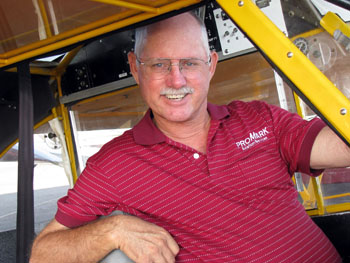
SAFE#: 0222 Hometown: Burnet, Texas Home Airport: KBMQ Occupation: Flight Instructor & owner, ProMark Aviation Services Education: B.S. Education, University of Texas at Austin Pilot Certificates: Commercial, CFII, IGI Airplanes Flying/Flown: Many SEL, currently Beech Bonanza, Piper Super Cub, Cessna 180, Cessna 172. Educational Specialty: Tailwheel and advanced IFR |
Q & A
| What drew you to aviation? A fascination with flight. My dad was a P-51 pilot in WWII which, I’m sure, had something to do with it. The seed lay dormant until I was in college and a friend suggested an airplane ride. Afterwards, neither a lack of money, nor a full course schedule mattered as much as learning to fly. However, I did not dare to tell my parents until I completed my PPL.
How long have you been involved in aviation education? The rumor is that I learned to fly about the time the last of the dinosaurs died off. I became a flight instructor in 1974. I became a Master CFI in 2006. Although I have always instructed part-time, I have been a full-time instructor since 2002. What’s your favorite part of what you do in aviation education? The continuing joy of helping people achieve their aviation goals. It never gets old. Then, there is the challenge of staying abreast of technological change. Oh, and my association with other aviation educators who have taught me so much about what it means to be a teacher of flight. And then there is the view out the front of the Super Cub on an early morning lesson over the Texas Hill Country! What’s your least favorite part of what you do in aviation education? Well, let’s see – the rare student who really doesn’t want to be there, the summer heat in Texas, spins gone bad and the occasional near miss on a turkey vulture … that’s about it. Do you have a memorable aviation experience you’d like to share? There are really too many to choose. Mostly it is the friends I’ve made, the shared struggles as students learn their lessons, the early morning light across the lakes and hills and the quiet knowledge that I have played some small part in molding the student into a confident and competent aviator. Why did you join SAFE? Because several friends and colleagues made me aware that we really can change the way pilots learn. I simply could not pass up the opportunity to be a part of something so important and so necessary. SAFE represents a better way in which professional aviation educators can really make a difference while elevating the profession. What would you like to see change in aviation? There needs to be a greater emphasis on basic skills coupled with an increased focus on proper decision making. We need to model the training to the real challenges. More scenario based training with a healthy dose of fun will improve the completion rate and the quality of new pilots. Additionally, IFR pilots need programs to maintain and improve skills and knowledge. Any real hope for change lies with increased professionalism, compensation and recognition of aviation educators. Any suggestions on how the above might be accomplished? The FAA needs to address the Practical Test Standards and the regulatory minimums for VFR flight. SAFE will need to be very involved in providing guidance. New aviation educators need a mentoring process to help them realize a rewarding career with adequate compensation. Any accomplishments in, or noteworthy contributions to aviation and/or aviation education you’d like to mention? I am honored to be the 2009 CFI of the Year for the FAA Southwest Region. Occasionally AOPA Flight Training magazine has published an article or two. Currently, along with a few friends and fellow aviators, we are helping the pilots of the Kenya Wildlife Service (KWS) in their efforts to stop the murder of the magnificent animals of Africa. Who are your role models in aviation? Wow, tough question. I have so many who have helped me along the way. Certainly my father tops the list. Then, a couple of guys running a flight school in Burnet, Texas in 1976, so desperate for a charter pilot and instructor that they would take a chance on a brand new CFI. And there are the authors – Earnest Gann, Bill Kershner, John Eckalbar, Gordon Baxter and Lane Wallace. Oh, and there’s Bill Clark who continues to find a way to help the KWS pilots. Certainly my associates around the U.S. who, with the power of the internet, have allowed me to help in some small way to create SAFE. Anything else you’d like to add? Only that I cannot think of a better time to be an aviation educator. Someone said “the Baby Boomers are moving from making a living to making a difference.” I give thanks every day that I get to do this. Editor’s Note: Ken is also the Chair of SAFE’s Communications Committee |
